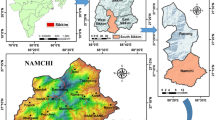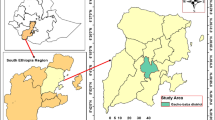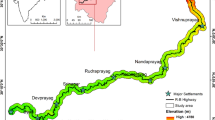Abstract
Landslides are one of the major natural hazards that are experienced in hilly terrains all over the world and Himalayas are no exception to this. Though primarily attributed to natural causes, landslides are increasing in frequency and magnitude due to anthropogenic disturbances. This has resulted in enormous damage to both life and property. Hence, identification of landslide prone areas is essential for safer strategic planning of future developmental activities. A landslide hazard zonation (LHZ) map is generated by multi-criteria evaluation (MCE) of various responsible factors like slope, drainage, land use and land cover, lithology, soil and aspect which are weighted on the basis of their relative contribution to the occurrence of landslides. These weights are normalized such that the sum of normalized weights is equal to unity. The study area is divided into five zones based on the deciles of the normalized weights. The results reveal that 40% of the area falls under high LHZ which needs immediate engineering and agronomic measures. The MCE model presented in this study could be utilized for other mountainous regions in general and Himalayas in particular.











Similar content being viewed by others
References
Abella EAC, Van Westen CJ (2008) Qualitative landslide susceptibility assessment by multicriteria analysis: a case study from San Antonio del Sur, Guantanamo. Cuba Geomorphol 94:453–466
Alcantara-Ayala I (2002) Geomorphology, natural hazards, vulnerability and prevention of natural disasters in developing countries. Geomorphology 47(2):107–124
Alexander D (1993) Natural disasters. UCL Press and Chapman & Hall, New York, p 632
Anbalagan R (1992) Landslide hazard evaluation and zonation mapping in mountainous terrain. Eng Geol 32:269–277
Bai S, Lu G, Wang J, Zhou P, Ding L (2011) GIS-based rare events logistic regression for landslide-susceptibility mapping of Lianyungang, China. Environ Earth Sci 62(1):139–149
Ballard TM, Willington RP (1975) Slope instability in relation to timber harvesting in the Chilliwack Provincial Forest. For Chron 51:59–62
Bhat I (2017) Landslide inventory and hazard zonation of Himalyas in North Kashmir, J&K. Unpublished M.Phil Thesis, University of Kashmi
Bhattacharya SK (2016) A comparison of the predicted vulnerability zones with the data based on hazard zones of landslide in the Kurseong hill subdivision, Darjeeling district, West Bengal. India. Environ Earth Sci 75:923. https://doi.org/10.1007/s12665-016-5729-8
Burton I, Kates RW (1964) The perception of natural hazards in resource management. Nat Resour 3:412–441
Calvello M, Peduto D, Arena L (2017) Combined use of statistical and DInSAR data analyses to define the state of activity of slow-moving landslides. Landslides 14(2):473–489. https://doi.org/10.1007/s10346-016-0722-6
Carrara A (1983) Multivariate methods for landslide hazard evaluation. Math Geol 15:403–426
Chauhan S, Sharma M, Arora MK, Gupta NK (2010) Landslide susceptibility zonation through ratings derived from artificial neural network. Int J Appl Earth Observ Geoinf 12:340–350
Chingkhei RK, Shiroyleima A, Singh LR, Kumar A (2013) Landslide hazard zonation in NH-1A in Kashmir Himalaya, India. Int J Geosci 4:1501–1508
Choubey VD, Litoria PK (1990) Terrain classification and land hazard mapping in Kalsi Chakrata area (Garhwal Himalaya), India. ITC J 1:65–68
Cruden DM (1991) A simple definition of a landslide. Bull Int Assoc Eng Geol 43:27–29
Dahal RK (2014) Regional-scale landslide activity and landslide susceptibility zonation in the Nepal Himalaya. Environ Earth Sci 71:5145–5164. https://doi.org/10.1007/s12665-013-2917
Dai FC, Lee CF (2002) Landslides on natural terrain-physical characteristics and susceptibility mapping in Hong Kong. Mt Res Dev 22(1):40–47
Das I, Sahoo S, Van Westen CJ, Stein A, Hack R (2010) Landslide susceptibility assessment using logistic regression and its comparison with a rock mass classification system, along a road section in the northern Himalayas (India). Geomorphology 114:627–637
Duzgoren-Aydin NS, Aydin A, Malpas J (2002) Distribution of clay minerals along a weathered pyroclastic profile, Hong Kong. CATENA 50:17–40
Feizizadeh B, Blaschke T (2011) Landslide risk assessment based on GIS multi-criteria evaluation: a case study in Bostan-Abad County, Iran. J Earth Sci Eng 1(2011):66–71
Feizizadeh B, Roodposhti MS, Jankowski P, Blaschke T (2014) A GIS-based extended fuzzy multi-criteria evaluation for landslide susceptibility mapping. Comput Geosci 73:208–221
Fredlund DG, Rahardjo H (1993) Soil mechanics for unsaturated soils. Wiley, New York, p 517
Ghimire M (2011) Landslide occurrence and its relation with terrain factors in the Siwalik Hills, Nepal: case study of susceptibility assessment in three basins. Nat Hazards 56:299–320
Gupta RP, Joshi BC (1990) Landslide hazard zoning using GIS approach—a case study from Ramganga catchment, Himalaya. Eng Geol 28:119–131
Hansen A (1984) Landslide hazard analysis. In: Brunsden D, Prior DB (eds) Slope instability. Wiley, New York, pp 523–602
He YP, Xie H, Cui P, Wei FQ, Zhong DL, Gardner JS (2003) GIS-based hazard mapping and zonation of debris flows in Xiaojiang Basin, southwestern China. Environ Geol 45:286–293
Islam ZU, Rao LAK (2013) Climate change scenario in Kashmir valley, India, based on seasonal and annual average temperature trends. Disaster Adv 6(4):30–40
Islam ZU, Rao LAK (2015a) Trends of winter and spring mean snowfall in Kashmir valley during the period 1981–2005. Nat Changes 2(1):1–10
Islam ZU, Rao LAK (2015b) Seasonal and annual rainfall trends: a perspective on climate change in Kashmir valley. Northwestern Himalayas. Nat Changes 2(2):1–13
Kayastha P, Dhital MR, Smedt FD (2012) Landslide susceptibility mapping using the weight of evidence method in the Tinau watershed. Nat Hazards, Nepal. https://doi.org/10.1007/s11069-012-0163-z
Kourgialas NN, Karatzas GP (2011) Flood management and a GIS modelling method to assess flood-hazard areas—a case study. Hydrol Sci J 56(2):212–225
Lee S, Choi J, Min K (2002) Landslide susceptibility analysis and verification using a Bayesian probability model. Environ Geol 43:120–131
Lineback Gritzner M, Marcus WA, Aspinall R, Custer SG (2001) Assessing landslide potential using GIS, soil wetness modeling and topographic attributes, Payette River, Idaho. Geomorphology 37:149–165
Lorentz JF, Calijuri ML, Marques EG, Alessandra CB (2016) Multicriteria analysis applied to landslide susceptibility. Mapp Nat Hazards. https://doi.org/10.1007/s11069-016-2300-6
Malik MI, Bhat MS, Najar AS (2016) Remote sensing and GIS based groundwater potential mapping for sustainable water resource management of Lidder catchment in Kashmir valley, India. J Geol Soc India 87(6):716–726. https://doi.org/10.1007/s12594-016-0444-3
Mathew J, Jha VK, Rawat GS (2007) Weights of evidence modelling for landslide hazard zonation mapping in part of Bhagirathi valley, Uttarakhand. Curr Sci 92(5):628–638
Nanda AM, Ahmed P, Kanth TA (2017) Rainfall induced landslide hazard assessment along NH 1D from Ganiwan to Gumri (J&K) India. Earth Sci India 10(IV):153–166
Pachauri AK, Pant M (1992) Landslide hazard mapping based on geological attributes. Eng Geol 32:81–100
Park S, Choi C, Kim B, Kim J (2013) Landslide susceptibility mapping using frequency ratio, analytic hierarchy process, logistic regression, and artificial neural network methods at the Inje area, Korea. Environ Earth Sci 68(5):1443–1464
Parry S, Campbell SDC, Churchman CJ (2000) Kaolin-rich zones in Hong Kong saprolites—their interpretation and engineering significance. In: Proceeding of geological engineering, Melbourne, Australia, p 6
Prior DB, Ho C (1972) Coastal and mountain slope instability on the islands of St. Lucia and Barbados. Eng Geol 6:1–18
Raza M, Ahmed A, Mohammad A (1978) The valley of Kashmir—a geographical interpretation, vol. I, the land. Vikas Publishing House, New Delhi
Regmi NR, Giardino JR, Vitek JD (2010) Modeling susceptibility to landslides using the weight of evidence approach: Western Colorado, USA. Geomorphology 115:172–187
Sarkar S, Kanungo DP, Mehrotra GS (1995) Landslide hazard zoning: a case study in Garhwal Himalaya, India. Mt Res Dev 15(4):301–309
Shafiq MU, Rasool R, Ahmed P, Dimri AP (2018) Temperature and Precipitation trends in Kashmir valley, North Western Himalayas. Theor Appl Climatol. https://doi.org/10.1007/s00704-018-2377-9
Shafiq MU, Islam ZU, Abida Ahmad W S, Bhat MS, Ahmed P (2019) Recent trends in precipitation regime of Kashmir valley, India. Disaster Adv 12(4):1–11
Shahabi H, Hashim M (2015) Landslide susceptibility mapping using GIS-based statistical models and remote sensing data in tropical environment. Sci Rep 5:9899. https://doi.org/10.1038/srep09899
Sharma M, Kumar R (2008) GIS-based landslide hazard zonation: a case study from the Parwanoo area, lesser and outer Himalaya, HP, India. Bull Eng Geol Environ 67:129–137
Sharma LP, Patel N, Ghose MK, Debnath P (2011) Landslide vulnerability assessment and zonation through ranking of causative parameters based on landslide density-derived statistical indicators. Geocarto Int 26(6):491–504
Terzaghi K, Peck RB (1967) Soil mechanics in engineering practice, 2nd edn. Wiley, New York, p 729
UNDRO (1982) Natural disasters and vulnerability analysis. Office of the United Nations Disaster Relief Coordinator, Geneva, Switzerland
Varnes DJ (1984) Landslides and other mass–movements, landslide hazard zonation: a review of principles and practice. UNESCO Press, Paris, p 63
White GF (1973) Natural hazards research. In: Chorley RJ (ed) Directions in geography. Methuen & Co Ltd, London, pp 193–216
Wu TH, Dwight AS (1978) Strength properties and their measurement in landslides: analysis and control, special report 176, edited by Robert L. Schuster and Raymond J. Krizek. National Academy of Sciences, Washington, D.C., pp 139–154
Yatsu E (1966) Rock control in geomorphology. Sozosha, Tokyo
Yin KJ, Yan TZ (1988) Statistical prediction model for slope instability of metamorphosed rocks. In: Proceedings 5th international symposium on landslides, Lausanne, Switzerland, vol 2, pp 1269–1272
Acknowledgements
Acknowledgements are due to Border Roads Organisation, Srinagar and various field departments for necessary data. Thanks are also to Dr. Gunter Dörhöfer Editor-in-Chief Environmental Earth Sciences, and anonymous reviewers for their valuable suggestions and comments which have greatly helped in improving upon the manuscript. Thanks are also due to Dr. Zahoor ul Islam and Dr. Mohammad Imran Malik, Department of Geography and Regional Development, University of Kashmir for his valuable suggestions and comments from time to time.
Author information
Authors and Affiliations
Corresponding author
Additional information
Publisher's Note
Springer Nature remains neutral with regard to jurisdictional claims in published maps and institutional affiliations.
Electronic supplementary material
Below is the link to the electronic supplementary material.
Rights and permissions
About this article
Cite this article
Bhat, I.A., Shafiq, M.u., Ahmed, P. et al. Multi-criteria evaluation for landslide hazard zonation by integrating remote sensing, GIS and field data in North Kashmir Himalayas, J&K, India. Environ Earth Sci 78, 613 (2019). https://doi.org/10.1007/s12665-019-8631-3
Received:
Accepted:
Published:
DOI: https://doi.org/10.1007/s12665-019-8631-3




